Natasha Aldrich-Blake
As a multidisciplinary artist working at the intersection of ceramics and painting, my work has evolved through a unique thirty-year journey that encompasses textile design, clothing manufacture, furniture making, etching, and sculpture. This diverse path has revealed recurring themes in my work—patterns of life, family history, survival, expression, and the interplay between lost and remembered memories. My current work explores the tension between structured craft and spontaneous expression. While ceramics demands precision and respect for tradition, my painting offers liberation from these constraints. Rather than seeing this as a conflict to resolve, I'm increasingly drawn to investigating this creative friction as a source of insight and innovation.
Initially resistant to theoretical frameworks, I now find myself curious about the very boundaries I once avoided. Doreen Massey's work on space as a relational construct edges toward my ideas about how making processes intersect with memory and time. This perspective, combined with Barrett and Bolt's research methodology, validates my intuitive understanding that knowledge emerges through the making process itself, rather than from predetermined outcomes.
The MA at Arts University Plymouth presents an ideal environment to deepen this investigation. The program's emphasis on diverse crafts aligns with my need to expand and refine my approach while maintaining the freedom to experiment and, when necessary, abandon unproductive paths. The university's strong tradition in both contemporary and traditional crafts provides the perfect context for exploring the dialogue between historical techniques and modern expression.
My work draws inspiration from varied sources—from Jessica Cooper's minimalist representations to Rothko's emotional depth, from ancient Minoan ceramics to the enduring influence of the Leach tradition. These seemingly disparate influences reflect my interest in bridging temporal and cultural gaps through material exploration. The MA would provide structured space to examine these connections more deeply and develop a more cohesive theoretical framework for my work.
My extensive experience in various crafts has taught me the value of technical mastery while maintaining creative flexibility. Through the MA, I aim to challenge my established patterns and push beyond comfortable methodologies. The program's emphasis on critical thinking and material research would help formalize my intuitive understanding of craft's role in contemporary art.
Looking ahead, I envision developing work that more deliberately explores the intersection of traditional craft techniques with contemporary artistic expression. The MA would provide crucial support in contextualizing my work within broader theoretical frameworks while maintaining the authenticity of my material-led approach.
Arts University Plymouth's reputation for fostering experimental approaches while respecting craft traditions makes it an ideal environment for this next phase of my development. The university's commitment to research through making and its strong community of diverse makers would provide valuable perspectives and opportunities for collaboration, helping me bridge the gap between intuitive making and structured inquiry
2020 2024 functional ceramics
selection of works over the last few years.. looking at materials, local vs standard clay. Much of this clay is foraged.
yellow is a constant theme, jumping off point.
firing types and surface texture all play into the exploration of form and use



































2023 non functional/surface exploration







recent paintings
exploration of colour and material. cold/hot wax. oil. damar, oil pastels. field uses, habitations, iconography, lost memories, family decisions. mostly on panel. less than 1ft
















2024 intaglio etching (tetra pak)



















1994 BA Hons sketchbook
Final year sketchbook, exploring landscape and lines. Interesting from a distance of 30 years.. I avoided direct evidence of habitation. But field boundaries and land use still informed the composition
I worked from either end of the book and the back pages were dedicated to more traditional watercolour and representative work. Whilst from the front, the work became more expressive and free. The very fact that this work could not be separated and therefore “displayed” released any need to be concerned about it being finished.





























